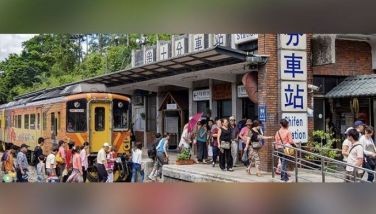Leonardo L. Co: His research on Phl plants abbreviated, gunned down
(First of two parts)
The bullets that felled Leonardo L. Co in Kananga, Leyte province, have left a void in the already depleted and anemic population of active Filipino plant scientists or botanists. There are at present less than 300 active MA, PhD and DSc degree holders in biological sciences per million people in the Philippines, and on these researchers’ shoulders rest the R&D programs of the government. The departure of Leonard from the science community will be felt tangibly by us aquatic and terrestrial biology researchers and scientists.
I offer this article to our late comrade in S&T by sending him off to his Creator with a “21-gun salute” he so deserves, coupled with a heartfelt commendation for his vast contributions to the study on the Philippine terrestrial flora, his constructive suggestions/ideas presented during our many technical meetings, his research results in both national and international S&T fora, and his books now being used by students and researchers. We were also colleagues, as accredited members of the National Research Council of the Philippines (NRCP), and the Association of Systematic Biologists of the Philippines (ASBP), among other S&T organizations committed to botanical research.
Other than the hullabaloo by certain senators (who have turned silent lately) wanting to investigate the incident that punctuated the life of Leonard Co, it seems that his demise from the face of Philippine flora research has not merited the attention, nor touched the hearts of the DOST leadership (the supposed guardian agency of researchers/scientists), nor the handlers (the CHR included) of the present dispensation. Even the national media sector has treated the issue coldly, but for minor mention about it in print, radio broadcast and TV! Kudos, however, to the management of Leyte Samar Daily Express who had bravely treated the incident with a roaring headline after the killing. Such is the stark reality, a scenario likely to continue for S&T workers who would suffer the fate of Leonard. Indeed, the Philippines will need the next millennium for its S&T level to be at par with its fellow ASEAN counterparts, what with the dwindling population of Filipino MA, PhD and DSc active researchers, which even now is already well below the expected 350 warm-bodies per million population prescribed by UNESCO!
By sheer coincidence, I found myself the first researcher/colleague to have known about the death of Leonard. It was an early morning call from my brother (Dr. Angel A. Cordero), a retired police colonel and now a non-uniformed personnel head of SOCO of PNP Region 8 Command, who led the team to the hinterlands of Kananga, Leyte. He called me up after discovering that one of the three victims was a botanist (Leonard). I requested him to promptly attend to the case and render his report. My brother called up again to tell that the bereaved wife of Leonard initially hesitated, but later acceded to have the remains autopsied. Incidentally, before Day 1 (Nov. 20) of the 10th International Long-Term Ecological Research (ILTER) Convention at the CHED Auditorium in Diliman, Quezon City, I already relayed the sad news to the committee chair, Dr. Victor Amoroso, for him to announce to the convention participants and for them to offer a prayer for our departed comrade in biological research.
My most recent association with Leonard was as fellow founding officer/member of the Philippine National Committee on DIVERSITAS and ILTER. The committee, linked with similar committees in many countries around the world, involves a number of Filipino terrestrial and aquatic biologists to craft strategies and tackle issues on biodiversity and ecology research. Leonard was the focal person on the biodiversity research of land ecosystem for Luzon, while I myself am assigned to the study of the aquatic ecosystem of the Visayas.
Definitely, the untimely demise of Leonard has left a vacuum on who will continue with his work on the taxonomy/systematics of the flora in the Sierra Madre and other highland habitats. Was it a wrong decision for him to have accepted the Energy Development Corp. (EDC) offer to avail of his expertise to survey and botanize the plant population of the geothermal production field in Kananga, Leyte — outside of the turf assigned him by the Philippine National Committee? Well, not really, because true plant researchers know no boundaries especially when one does biodiversity, floristic or ecological studies!
Months have passed since the death of Leonard and his companions (Sofronio Cortez and Julius Borromeo), yet his family, the families of his companions, and we, in the Philippine science community, continue to be in quandary about the real cause of the incident. We share the pains of waiting for justice to be achieved. Sources have it that SOCO findings about Leonard’s death submitted to the PNP Region 8 Command have not been accessible to the media! The continued deafening silence about the three victims of the alleged “encounter or crossfire” between the AFP elements and the NPA, have kept the public crossing their fingers, waiting for the powers-that-be to announce their final and comprehensive investigation report, detailing the circumstances about the death, the identity of the perpetrator/s and the corresponding verdict.
(To be continued)
* * *
Dr. Paciente A. Cordero Jr. is a marine biologist/phycologist and professorial lecturer and author of marine biology, ecology and mariculture subjects. He is the immediate past executive director of the National Research Council of the Philippines, Department of Science and Technology (NRCP-DOST). He is presently a visiting scientist at the Visayas State University-Tolosa, base of his NRCP-funded project on the “Biodiversity and Potential of the Marine Algae of Leyte Island-NE Phase.” His current advocacy is to tap the seaweed resources of Region 8 through mariculture of edible seaweed species, and to promote acceptance as food by fellow Eastern Visayans the nutrient/protein-rich sea vegetables. He hails from Burauen, Leyte. E-mail him at [email protected].
- Latest




























